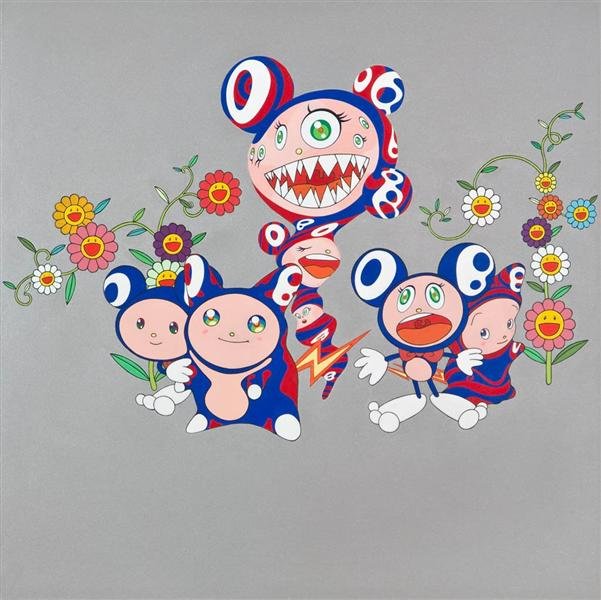“[A]ll art in the late capitalist society of high-powered media spectacles is, in a certain manner of speaking, ‘cute.’”
– Sianne Ngai, Our Aesthetic Categories: Zany, Cute, Interesting, 2012
With Bonito Generation, Kero Kero Bonito get big and ambitious. Exercising a more polished sound than heard on their debut Intro Bonito, which felt somewhat dinky by design — it was often centered around decisively hollow chiptune-inspired arrangements — Bonito Generation is its own self-reflective hit parade carrying with it five pre-album singles and the potential for at least a few more. By climbing toward radio pop production — a direction first established with 2015’s non-album single “Build It Up” — KKB have made an optimistic and important step toward a wider listenership, including the potential for a mainstream pop audience. Fine-tuning the subversive attitude behind their naive front, KKB rides the narrow frequency that sits between uncritical pop product and art school radio, and in so doing manage to nonchalantly and charismatically critique their surroundings.
To better understand why KKB seems to be so effective and unique in their success, I have turned to theorist Sianne Ngai and her book Our Aesthetic Categories: Zany, Cute, Interesting, in which she poses the qualities of zaniness, cuteness, and interestingness as those “best suited for grasping how aesthetic experience has been transformed by the hypercommodified, information-saturated, performance-driven conditions of late capitalism.” Ngai’s argument draws from mass media and consumer products as well as conceptual art and the avant-garde, because, she argues, our aesthetic understanding is deeply rooted in our way of life and that our affective engagements with aesthetics occur from the impenetrable cuteness of Gertrude Stein’s “little called anything[s]” to the zany danger of Jim Carey’s cable guy. This range of material is particularly useful in the case of Bonito Generation, because the song form is one of the few mediums of cultural consumption that has a proven history within the fields of mass calculated consumerism via pop charts as well as esoteric experimentation in the underground. At the intersections of these diverse engagements with the song form, as well as the aesthetic categories of the zany and the cute, lie Kero Kero Bonito.
Take, for example, the album’s latest single, “Trampoline,” a slyly tongue-in-cheek anthem that lands somewhere between an upbeat Calvin Harris hit and a Yo Gabba Gabba lesson about trying our hardest. The song establishes a number of pop tropes (digitized voice, unabashedly inspirational lyrics, dramatic breaks, a spoken word bridge) only to amplify and exaggerate their features, using caricature to divisively introduce musical excess and absurdity. As impossible dance cues are called out (“Full twist, backflip/ Just set your body free”) and a rap verse in Japanese is speedily recited, “Trampoline” comes down on its pseudo-motivational bridge: “Even if you’re falling, that’s okay/ There’s a trampoline waiting for you/ It’s so easy, you just have to believe.” With this, KKB bounce back even higher, changing keys for the final chorus and frantically shifting singer Sarah Bonito’s voice for the ecstatically zany outro.
What is especially effective about “Trampoline,” however, that is less successfully accomplished by many other hyper pop acts — namely KKB’s PC Music affiliates — is that KKB begins with a devout adoration for the pop chart-toppers that the latter often seek to transcend and, by so doing, belittle. Whereas artists like SOPHIE and Hannah Diamond have adopted cuteness from pop music in part for disassociation, KKB acknowledges the limits of the mode, works within them, and directs their critique at more specific issues and ideologies — namely, in the case of “Trampoline” as well as the earlier “Build It Up,” the “you can do anything” attitude best established and typified by Katy Perry’s “Firework,” which, while apparently useful for messages of self-empowerment, is a sentiment that is uniquely enabling for capitalist take-what-you-want politics, a practice clearly linked to privilege. KKB concede to this in that brief and snarky bridge, which is built upon the truth that not everyone has a trampoline waiting to catch them, a truth all too relevant for culturally subversive and ironic art-makers. This is why when Ngai says that “all art in the late capitalist society of high-powered media spectacles is, in a certain manner of speaking, ‘cute’” and notes “the avant-garde’s lack of political consequentiality” and tendency to be “absorbed and recuperated by the cultural institutions it initially opposes,” the boldness of becoming less like art and more like pop is illuminated.
Songs like “Heard A Song” and “Break” find Sarah at her most charismatic pseudo-naivety, as she narrates her carefree navigation of the world (perhaps most accurately approximated by the video for the Len classic “Steal My Sunshine”). The outspoken ambivalence of her character is essential to her performance of both the cute and the zany.
On “Lipslap” however, Sarah protests her typically docile and minimalistic persona with a fury regularly subdued elsewhere. Stepping into the shoes of an uptempo house MC, she states “Can’t believe I have to rap on tracks so you get it/ Wanna talk about so much stuff then you just give me hush.” Sarah Bonito takes the space provided by the beat for her own self-empowerment, protesting the inherent violence of cuteness (the cute object is registered as subordinate to the subject that judged it so) as well as demonstrating the cute subject’s quick slippage to monstrosity (see Fig. 1 — example taken from Ngai’s tracing of the long-form transformation or “melting” of Takashi Murakami’s character Mr. DOB from the small-featured and shy iteration found to the left to the vicious and imposing monster in the middle). As Ngai states, “Sanrio’s Hello Kitty […] has no mouth at all. Thus while de Man equates the endowing of speech with ‘giving face,’ ‘giving face’ in cuteness seems to amount to denying speech.” It is therefore worth noting that “Lipslap” is one of two songs on Bonito Generation that has no Japanese lyrics, not only making it’s content clear to English-speaking listeners, but shedding any possibility of projection (foreign syllables can more easily be consciously or subconsciously read as silence or babble for an oblivious listener) or calls to cute’s aesthetic cousin kawaii.

Zaniness — an aesthetic that Ngai argues is about “a strenuous relation to playing that seems to be on a deeper level about work […] in which the potential for injury always seems right around the corner” — is exhibited on “Heard A Song,” when Sarah “stops [her car] in the middle of the street” because the song on the radio is so “sweet.” Zany characters like Sarah Bonito, Pee-wee Herman, and (as Ngai cites) Lucille Ball’s Lucy draw our attention because they mimic and mock our unnerving duty under capitalism to endlessly perform the undifferentiated roles of worker and consumer while at times trying to make sense of our “selves” outside of them (an impossible task).

Pee-wee Herman, to lend an example, directly troubles the distinction between work and play through the very premise that his time in his playhouse is a large, often delusional, orchestrated performance for a televised audience. Pee-wee is all the more zany for his tendency to code-switch (not unlike the bilingualism of KKB), using innuendo to not only entertain the adult parent audience but also maintain the intriguing potential for the hazard that he may one time be too clear or go too far (“injury always seems right around the corner”). This facet of Pee-wee’s performance was later troubled by the soon-notorious public sexuality of his actor/creator Paul Ruebens — a very real dissonance between the work of production for adolescent consumption and the adult play of sexuality occurring at the nexus of biography and fiction, the artist (play) and his work. Pee-wee’s zaniness — his ability to both worry us and lure us in — resonates well with the caricature around which KKB is formed. While Ruebens perhaps used Pee-wee to discreetly investigate the intersection between child’s play and sexuality, KKB’s zaniness hyperbolizes a stereotypical identity (the cute, playful, and innocent Asian woman) to dismantle it and allow room for more general critique (often anti-capitalist and feminist).
I don’t want to further exhaust and over-explain the sly humor that Bonito Generation offers, but I urge a consideration of it as just as important and influential a work as many more acceptably “serious” ones. Noting a shift from such grandiose categories as the beautiful or the sublime to ones seemingly more trivial (like the zany and cute), Ngai states, “the increasing interpenetration of economy and culture” has brought about “a destabilization of art’s more specifically modernist, twentieth-century mission of producing perceptual shocks. […] [W]eaker aesthetic categories crop up everywhere, testifying in their very proliferation to how, in a world of ‘total design and internet plenitude,’ aesthetic experience, while less rarefied, also becomes less intense.” By allowing theirselves to occupy a space of vulnerability via sincerity toward diminutive aesthetic choices — against the hyper-capitalism of the pop world and the critical cool of the art world — KKB boldly steps up to a greater social presence, and I hope they find as much commercial success as possible: resting on pop charts, scoring up video games, and providing better pop music for tween eardrums.
More about: Kero Kero Bonito




